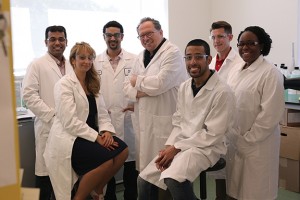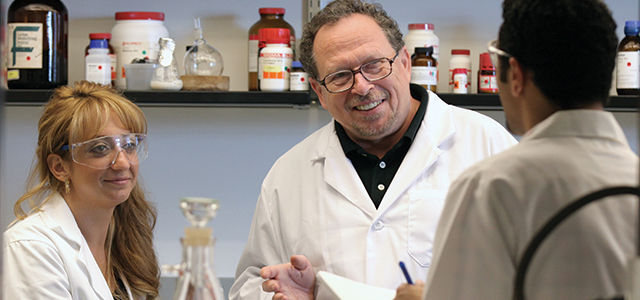When people think of solar energy, they imagine harnessing the sun’s rays to heat their homes and power their vehicles. But solar energy has many other practical applications, and new research conducted by a group of scientists at Seton Hall — led by associate professor Sergiu Gorun — is investigating how to use the sun’s energy to fight cancer.

“These new cancer-fighting molecules have the potential to be more selective in terms of eradicating the cancer itself, so they harm less healthy tissue, and generate fewer side effects than traditional [cancer] treatments,” says David Sabatino, an assistant professor in the department of chemistry and biochemistry, who has collaborated with Gorun to refine the materials used in the research.
Their research also may apply to other diseases — such as macular degeneration, a condition that can cause loss of vision — and to removing pollutants from the environment.
Gorun uses the term “bio-inspired catalysis” to describe what happens in photodynamic therapy, where solar energy is converted to chemical energy. He compares it to the way plant leaves create nutrients from water and carbon dioxide during photosynthesis, helping remove pollutants from air and water.
His research operates on a similar principle, he says. “Oxygen, upon absorbing energy, becomes reactive and, as a result, is able to perform certain chemical functions, including the deactivation of malignant tumors or environmental pollutants.”
A leading researcher
Gorun came to the United States in 1980 as a political refugee from Romania, bringing with him an “irrepressible curiosity about the world and the desire to create a better one.” Armed with a master’s degree from Columbia University and a doctoral degree from Massachusetts Institute of Technology, he set his sights on first designing, and then researching, the reactive properties of artificial enzymes and related materials.
The holder of numerous patents and the author of an array of academic articles in top scientific journals, Gorun has received financial support for his research and educational efforts from the Department of Energy, the Department of Defense, the National Science Foundation and other granting agencies.

The educational component of Gorun’s research is complemented by collaborative work with scientists throughout the United States, as well as in Canada, Israel and Europe.
“The type of coordinated, cutting-edge work Sergiu’s team and other faculty are doing, coupled with the caliber of science being explored throughout the Department of Chemistry and Biochemistry as a whole are what led to it being named a Seton Hall Center of Excellence,” says Joan Guetti, senior associate provost.
The department was chosen as a Center of Excellence in 2014 as part of a program in the University’s strategic plan that channels resources into key areas to allow them to expand in size, depth of study and national prominence.
“Seton Hall has been particularly supportive of our team’s efforts,” Gorun says. “The University has created an ideal environment for accomplishing our goals with this critical research.”
Martta Kelly is a freelance writer living in West Orange.







